Not only do plants add a touch of life and comfort to your office space, but they also can improve air quality. Flourish in health with our guide of the best plants for your office!
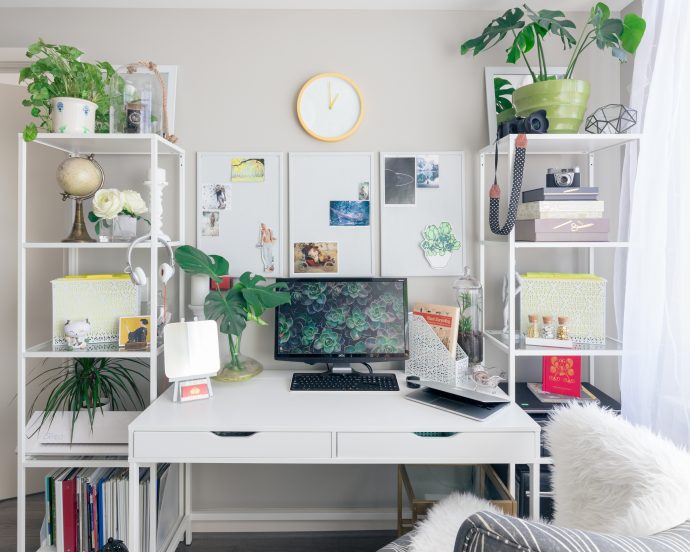
To help us determine our list we enlisted the help of D.C. based Little Leaf Shop and global, living wall experts, Sagegreenlife.
As houseplants are making a comeback into the homes of millennials and beyond, they have also crept their way into the workplace. Not only are they a welcome distraction from grey, fluorescent-lit office spaces, but numerous studies have shown their ability to decrease stress and increase productivity.
Plants in the workplace have been deemed restorative, accelerating your brain’s ability to recover from fatigue and stress. Despite your reasons for bringing leafy friends into your concrete jungle, plants have certainly proven their rightful place on our desks (and our hearts).
Many of the plants below are known for air purification. Dracaena Marginata and Sanseviria are even listed in NASA’s Clean Air Study, which outlines plants that can eliminate a number of dangerous air born chemicals, including benzene (found in detergents, paints and gasoline), trichloroethylene (used in paints and adhesives) and formaldehyde (found in wall paneling and kitchen cabinets).
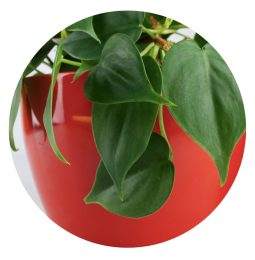
Philodendron Cordatum – ‘Sweetheart Vine’
Description: This elegant vining plant is a versatile workhorse. Not only does this philodendron species come in several color variations from standard green to neon to my favorite variegated form, Brazil, but it is also one of the easiest plants to care for. It tolerates high to low light levels and can withstand a missed watering or two!
Care: Allow to dry down completely in low to medium light between watering, but not to point of wilting.
Sun: This plant does best if placed in indirect light. Keep out of direct sun, bright diffused light is preferable.
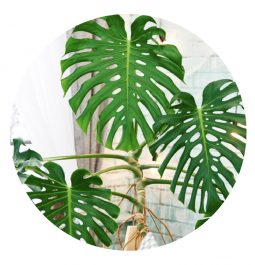
Philodendron Monstera – ‘Monstera’
Description: This giant is the social media superstar of the plant world. It can get quite large, so keep that in mind when deciding on placement. It’s the quintessential specimen if you are looking to add large scale greenery to your workplace.
Care: The plant needs warm interior temperatures of at least 65 degrees Fahrenheit (18 C) or warmer. Plant in a peaty, well-draining soil in a pot with drainage holes. Water when the top quarter-to-third of the soil feels dry to the touch.
Sun: Too much harsh sunlight can result in scorching, but if it doesn’t get enough the plant may not develop as many perforations in its leaves.
Tillandsia – ‘Air Plant’
Description: For those with an already-cluttered desk: these plants don’t require soil and come in tiny sizes, meaning there’s always room for one more.
Care: Dunk in a mug full of water once per week to keep them happy and thriving.
Sun: Air plants prefer bright, indirect light (or fluorescents!). Periods of direct sunlight are ok, but more than a few hours of sun will dry them out.
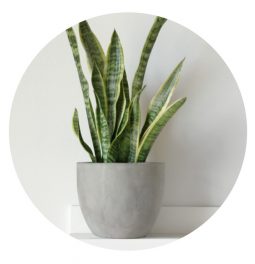 Sansivieria – ‘Snake Plant’
Sansivieria – ‘Snake Plant’
Description: Also known as the ‘Mother-In-Law Tongue,’ this plant is hands-down the easiest indoor plant to care for, thriving in even the most difficult interior settings. Most varieties have the added bonus of upright vertical growth, which lends itself well to modern or minimal design themes.
Care: This plant can go weeks between waterings with no long-term ill effects – perfect for frequent travelers!
Sun: The snake plant can tolerate almost any level of light – great for offices or desks without a window.
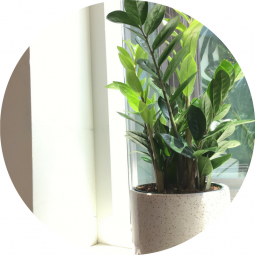
Zanzibar Gem – ‘ZZ Plant’
Description: Similar to the snake plant, the ZZ plant is great the frequent traveller who needs a plant that thrives on neglect.
Care: ZZ plants will do better if you leave them alone! ZZ’s have bulb-like roots, meaning they only need water once a month or when the soil has dried out.
Sun: ZZ plants do best in bright to moderate, indirect light but also thrive low light. While ZZ plants can take direct light, you could see some scalding on the leaves.
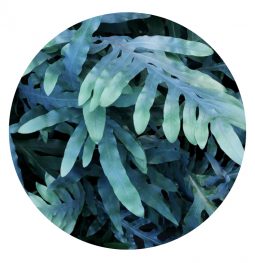
Phlebodium Aureum – ‘Blue Star Fern’
Description: The ‘Blue Star’ has been blessed with an unusual powdery blue color that appears as a beautiful, silvery aqua. Simple to care for, it requires low, indirect light (less than your average fern) and even moisture. To keep the fronds looking clean and unblemished, place a humidity tray underneath its pot, or group the plant with others to increase humidity levels.
Care: The blue start fern does well in the lower light conditions found in most interiors. It enjoys moist soil, so it’s hard to overwater this one!
Sun: This plant tolerates low light. Place it in indirect light toward the center of the room.
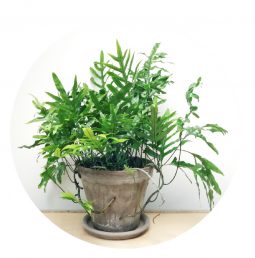 Osorum Diversifolium – ‘Kangaroo Paw Fern’
Osorum Diversifolium – ‘Kangaroo Paw Fern’
Description: A native to Australia, this forgiving fern provides an abundance of shiny emerald green fronds year-round. As a compact variety only reaching about one foot in height, it is perfect for a desk or smaller areas that receive any level of light. Its sprawling rhizomes often trail out of its container, adding extra interest to its appearance.
Care: Water when the top half of the soil has dried.
Sun: This plant prefers medium to bright indirect light.
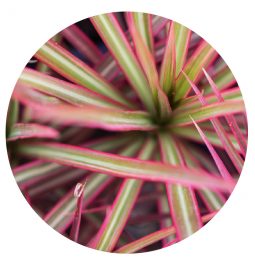
Dracaena Marginata – ‘Colorama‘
Description: When looking to add a splash of color to your greenery, dracaena marginata is a perfect choice. This newer variety ‘Colorama’ is stunning with its bright magenta, green and cream variegation. Incredibly easy to maintain, this plant can grow to fit spaces of virtually any size, from a 4-inch container to a 6-foot tree.
Care: Water when the top 2-3 inches of the soil is dry.
Sun: When used in interiors, keep it in the brightest areas to help maintain its saturated colors.




Where to buy these plants !?
The most important thing about these kinds of things – ie plants is to take care of them all the time. And, of course, if you’re relocating your office – to make sure they’re safe while they’re being transported. You see, some of us, at our office had a favorite plant – Bob. And Bob survived the relocation thanks to these dudes – http://cityremovalist.com.au/eastern-suburbs/ . So, take care of your plants even when relocating, please.